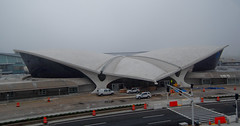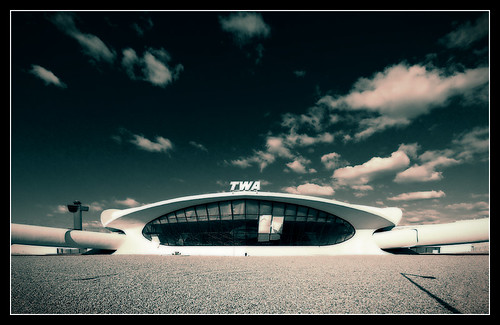 |
| Pan Am Worldport Gottscho-Schleisner, Inc., photographer in the Public Domain |
The TWA Flight Center, designed by Eero Saarinen, still stuns visitors with its unique profile. A thin-shell concrete structure which evokes a bird in flight. Opened in 1963, it introduced travelers to such niceties as the Jetway boarding bridge, a central PA system, and an electronic flight display board.
By the early 1990s these buildings were all bursting at the seams and barely able to cope with the volume of traffic passing through them. Piecemeal renovations occurred on each facility. Used by Delta since Pan Am's demise, the Worldport is often compared unfavorably to terminals in the developing world. It is slated to be demolished by 2014. A consortium of airlines replaced the Eastern terminal with a state-of-the-art facility that can accommodate the superjumbo A380. American built a giant new structure and leveled both its original building (which included destroying the world's largest stained-glass window) and that of United, whose presence at JFK has been reduced to just a handful of flights now operating out of the British Airways facility. I.M. Pei's glass-curtained "Sundrome," which housed jetBlue until a few years ago, is also slated to come down to make room for that carrier's future expansion.
The main terminal has also been replaced, and will be expanded to accommodate Delta over the next few years, thus vacating the Worldport.

TWA Flight Center by Eric Alix Rogers 2009
The TWA Flight Center is now on the National Register of Historic Places. Its unique shape and the inability to alter it made it impractical for today's requirements. When American Airlines consumed TWA in 2001, the terminal was closed.
Since then jetBlue built a new facility partially surrounding it on the airside, which required demolition of the two gate satellites, but the two buildings are joined by the two original ovid walkways in which we see Leonardo DeCaprio, in character as master con artist Frank Abagnale, Jr. in Catch Me if You Can.
 |
| Airside of the TWA Flight Center by Timothy Vogel (Vogelium on flickr.com) Used by Creative Commons License |
The latest proposal is to construct a boutique-sized hotel (approximately 150 rooms) in the space between the old and new buildings. I'm not sure how they plan to accomplish this without further compromising the setting of the Saarinen structure. The airside is currently a gravel field, but at least that admits daylight into the cavernous waiting area. Sticking another building in there would gobble up even more of the already-limited atmosphere. A hotel on the airport property would be a good thing (the vaguely prisonlike Ramada Plaza out by the Belt Parkway closed several years ago) but I'm not sure wedging it into this space is the best plan, and I'm not alone.
Bon tardi! I love the look of your blog - clean and sleek. I always learn about travel and something special about faith from your posts. Thanks for following my blog as well. Cheers to you!
ReplyDeleteHere are some more photos of JFK (then New York International or -- as it was more familiarly known -- Idlewild)
ReplyDelete